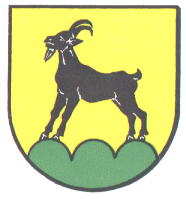Gaisburg: Difference between revisions
Jump to navigation
Jump to search
Knorrepoes (talk | contribs) m (Text replacement - "{{de}} '''" to "{{de}} '''") |
Knorrepoes (talk | contribs) m (Text replacement - "===Origin/meaning=== The" to "===Origin/meaning=== The") |
||
| Line 20: | Line 20: | ||
===Origin/meaning=== | ===Origin/meaning=== | ||
The oldest known seal of the village council dates from the 18<sup>th</sup> century and shows a goat on a mountain. The composition appears in a shield in a 19<sup>th</sup> century seal. One other 19<sup>th</sup> century seal, simply shows a jumping goat, no mountain. Late 19<sup>th</sup> century seals show again the arms. The arms are canting, a goat (Geiss) on a mountain (Berg). | The oldest known seal of the village council dates from the 18<sup>th</sup> century and shows a goat on a mountain. The composition appears in a shield in a 19<sup>th</sup> century seal. One other 19<sup>th</sup> century seal, simply shows a jumping goat, no mountain. Late 19<sup>th</sup> century seals show again the arms. The arms are canting, a goat (Geiss) on a mountain (Berg). | ||
Revision as of 08:18, 18 July 2022
This page is part of the German heraldry portal Deutsche Wappensammlung |
Heraldry of the World |
|
German heraldry:
|
Selected collector's items from Germany:
|
GAISBURG
State : Baden-Württemberg
District (Kreis) : Stuttgart
Incorporated into : 1901 Stuttgart
| German | |
| English | No blazon/translation known. Please click here to send your (heraldic !) blazon or translation |
Origin/meaning
The oldest known seal of the village council dates from the 18th century and shows a goat on a mountain. The composition appears in a shield in a 19th century seal. One other 19th century seal, simply shows a jumping goat, no mountain. Late 19th century seals show again the arms. The arms are canting, a goat (Geiss) on a mountain (Berg).
Contact and Support
Partners:
Your logo here ?
Contact us
© since 1995, Heraldry of the World, Ralf Hartemink 
Index of the site
Literature : Bardua, 1973.












